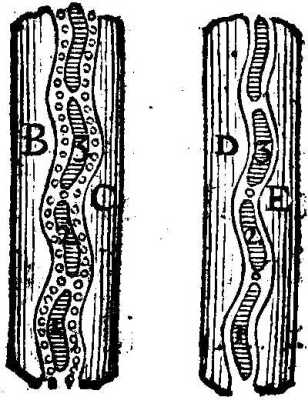Fire from Dried Leaves
Table of Contents
92. Fire in those that heat up but do not shine like enclosed hay
The particles of some spirit or liquid can sometimes ignite fire by passing through the channels of a hard or liquid body.
This is demonstrated by:
- wet hay enclosed in a space
- lime sprinkled with water
- all kinds of fermentations
- several chemical liquids known to alchemists which heat up and sometimes even catch fire when mixed together.
Fresh hay, if stored before drying, gradually heats up and spontaneously catches fire.
This is because many spirits or juices are accustomed to flowing through the pores of green plants from their roots to their tips.
- They stay for some time in the cut hay.
If this hay is enclosed in a narrow space, its juices migrate from one leaf to another.
- They find many channels to be slightly narrower in the already-drying leaves.
- These have less air-aether globules.
They flow through these narrow channels, they surround only the fire-aether which swiftly drives them to acquire the agitation of fire.
Let:
- the space between two bodies
BandCrepresent one of the channels of a green leaf - small loops
1, 2, 3which surround it be the particles of juices or spirits usually conveyed by air-aether globules through such channels- These follow a moderate motion of the air-aether between
BandC
- These follow a moderate motion of the air-aether between
- the space between bodies
DandEis another narrower channel of a drying leaf- Here, traversing it, the same particles
1, 2, 3can no longer surround the air-aether but can only have the fire-aether around them - These follow a very swift motion of the fire-aether between
DandE.
- Here, traversing it, the same particles

Even if only a very small quantity of this fire-aether is found around the juice particles between D and E, the important thing is that they adhere to it entirely.
This is similar to a ship descending in a stream. It easily follows the stream’s course when it is so narrow that it almost touches its banks on both sides, just as it does when it is widest.
Therefore, such swiftly moving juice particles have much more power to separate the surrounding hay particles than the fire-aether itself.
This is similar to a ship colliding with a bridge or obstacle shakes it more forcefully than the water of the river that carries the ship.
Superphysics Note
Therefore, rushing into the denser particles of the hay, the juices easily separate them from each other, especially when many of them rush from different sides.
- When they separate enough of them and carry them away, there is fire.
- When they merely shake and do not yet have the power to separate many from each other, they slowly heat and spoil the hay.
93. Fire in lime sprinkled with water and others.
A hard body can be heated by the addition of some liquid.
This happens when its channels are of a size can allow only the particles of this liquid, surrounded by the fire-aether, to pass through.
A similar explanation applies when one liquid is poured into another.
One of them always consists of branched particles, somehow intertwined and knotted.
- It thus mimics the properties of the hard body with channels.
- This property is related to the exhalations themselves.
94. How fire can be ignited in the cavities of the earth
Inside the Earth’s cavities, the sharp spirits of dense exhalations can penetrate as to ignite flames within them.
The fragments of rocks or flint are worn away by the secret flow of water or other causes which fall from the vaults of the cavities to the substrate soil.
These can both explosively expel intercepted air and ignite fire by the collision of flint.
Once one body has conceived fire, it easily communicates it to other nearby bodies suitable for receiving it.
For the particles of fire*, meeting the particles of those bodies, move them and carry them away. However, this pertains more to the preservation of fire than its generation, which will be discussed later.